All Categories
Featured
Table of Contents
Double Glazed Windows In Melbourne in Padbury Perth
Laminated glass is frequently utilized in locations in the house most prone to injury from human impact such as bathrooms, doors, around staircases and in areas near to the floor (it meets the requirements of 'safety glass' that is mandated for use in these areas by Australian Basic AS 1288 Glass in structures).
Toughened glass has actually been 'tempered' by being reheated and rapidly cooled again. This process makes it much more powerful than basic glass it can resist greater impact loads prior to breaking. It likewise makes it much safer because, when it does shatter, it burglarizes numerous little cubic pieces rather than unsafe fragments.
Double Glazed Windows In Melbourne in Myaree WA
However, toughened glass has no thermal or acoustic benefits over other glass of the very same toning or thickness. Secondary glazing is where single-glazed windows are retrofitted with a transparent acrylic or glass sheet connected to the within of the frame or openable sash with a secondary frame or with magnetic strips.


Secondary glazing will not perform also thermally as a manufactured IGU, because it is impossible to completely seal the boundary, but it can supply good noise control. Window films are a thin polymer film consisting of a soaking up color or reflective metal layer, with an adhesive backing. They stay with your glazing to alter its colour or make it reflective.
Double Glazed Windows in Cardup Perth
Applied to existing glass, some window movies can cut in half the general SHGC of the window by absorbing and/or reflecting solar radiation. This can be particularly helpful in hotter climates where cooling is the main issue, or on east and west elevations directly exposed to long durations of sunshine. Window films might also lower noticeable light transmittance.

For this reason, it is generally best to utilize a recognized installer of window movie. Frames have a substantial influence on the thermal performance of windows and doors, due to the fact that energy can be acquired and lost through the frame, as well as through the glass. Various types of frame will permit various levels of heat gain and loss, so careful option of frame is essential for efficient passive style.
Benefits Of Double Glazing Low-e in Darlington WA
Nevertheless, aluminium is also an excellent conductor of heat and will decrease the insulating worth of a glazing system, unless specifically crafted to decrease this. A 'thermally broken' frame is made up of 2 aluminium sections connected by a structural insulator (generally a low-conductivity structural polymer). This 'breaks' the thermal connection through the aluminium and lowers the heat flowing through the frame.
Wood frames are a good natural insulator that can match some home styles. Timber frames ought to be made from species that have naturally high toughness or be treated to prevent decay and contortion.
Why Do You Need Double Glazing Windows In Summer? in Murdoch Perth
This can result in gaps that permit air infiltration unless good draught sealing (weather stripping) is set up. u, PVC is a form of plastic (unplasticised polyvinyl chloride, also referred to as rigid PVC). u, PVC frames offer excellent thermal performance, typically better than wood or thermally broken aluminium. u, PVC is long lasting and requires very little maintenance, and can be moulded into complicated profiles that provide exceptional air seals.
u, PVC windows and doors have exceptional thermal performance Photo: Ben Wrigley (Light House Architecture and Science) Composite frames use aluminium profiles on the outer sections with either a lumber or u, PVC inner area. These combine the low upkeep and sturdiness of aluminium with much improved thermal efficiency.
Table of Contents
Latest Posts
The Surprising Benefits Of Double Glazing In The Summer ... in Dalkeith Western Australia
Why Install Stunning Double Glazing Windows During Summer? in Glendalough WA
Double Glazing Windows in Osborne Park Perth
More
Latest Posts
The Surprising Benefits Of Double Glazing In The Summer ... in Dalkeith Western Australia
Why Install Stunning Double Glazing Windows During Summer? in Glendalough WA
Double Glazing Windows in Osborne Park Perth